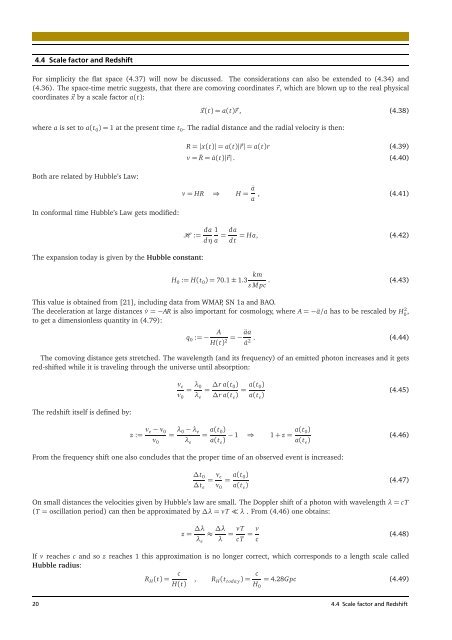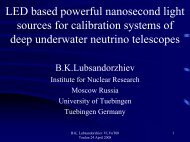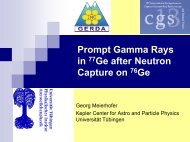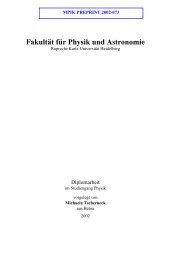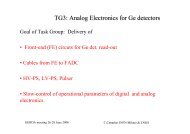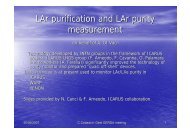Master Thesis
Master Thesis
Master Thesis
You also want an ePaper? Increase the reach of your titles
YUMPU automatically turns print PDFs into web optimized ePapers that Google loves.
4.4 ScalefactorandRedshift<br />
For simplicity the flat space (4.37) will now be discussed. The considerations can also be extended to (4.34) and<br />
(4.36). The space-time metric suggests, that there are comoving coordinates�r, which are blown up to the real physical<br />
coordinates�x by a scale factor a(t):<br />
�x(t)= a(t)�r , (4.38)<br />
where a is set to a(t 0)=1 at the present time t 0. The radial distance and the radial velocity is then:<br />
Both are related by Hubble’s Law:<br />
In conformal time Hubble’s Law gets modified:<br />
The expansion today is given by the Hubble constant:<br />
R=|x(t)|= a(t)|�r|= a(t)r (4.39)<br />
v=˙R= ˙a(t)|�r| . (4.40)<br />
v=HR ⇒ H= ˙a<br />
, (4.41)<br />
a<br />
� := da 1 da<br />
= = Ha, (4.42)<br />
dη a d t<br />
H0 := H(t 0)= 70.1±1.3 km<br />
. (4.43)<br />
s M pc<br />
This value is obtained from [21], including data from WMAP, SN 1a and BAO.<br />
The deceleration at large distances ˙v=−AR is also important for cosmology, where A=−ä/a has to be rescaled by H2 0 ,<br />
to get a dimensionless quantity in (4.79):<br />
q0 :=− A äa<br />
H(t) 2=− . (4.44)<br />
˙a 2<br />
The comoving distance gets stretched. The wavelength (and its frequency) of an emitted photon increases and it gets<br />
red-shifted while it is traveling through the universe until absorption:<br />
The redshift itself is defined by:<br />
z := ν e−ν 0<br />
ν 0<br />
ν e<br />
ν 0<br />
= λ 0−λ e<br />
λ e<br />
= λ0 =<br />
λe ∆r a(t 0)<br />
∆r a(t e) = a(t 0)<br />
a(t e)<br />
= a(t 0)<br />
a(t e) − 1 ⇒ 1+z= a(t 0)<br />
a(t e)<br />
From the frequency shift one also concludes that the proper time of an observed event is increased:<br />
∆t 0<br />
∆t e<br />
= νe =<br />
ν0 a(t 0)<br />
a(t e)<br />
(4.45)<br />
(4.46)<br />
(4.47)<br />
On small distances the velocities given by Hubble’s law are small. The Doppler shift of a photon with wavelengthλ=cT<br />
(T= oscillation period) can then be approximated by∆λ= vT≪λ . From (4.46) one obtains:<br />
z= ∆λ<br />
λ e<br />
≈ ∆λ<br />
λ<br />
= vT<br />
cT<br />
= v<br />
c<br />
(4.48)<br />
If v reaches c and so z reaches 1 this approximation is no longer correct, which corresponds to a length scale called<br />
Hubble radius:<br />
R H(t)= c<br />
H(t)<br />
, RH(t toda y)= c<br />
= 4.28Gpc (4.49)<br />
H0 20 4.4 Scale factor and Redshift


